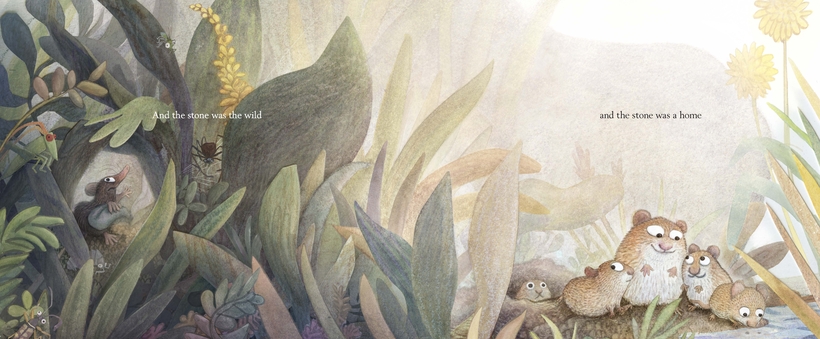A single stone, rock, boulder, or whatever may strike you as an implausible subject for a picture book. And true, after the folktale Stone Soup and William Steig’s Sylvester and the Magic Pebble, the shelf of first-rate lithologic literature for children lies fairly empty. So kudos to Brendan Wenzel for A Stone Sat Still, which, as the title suggests, is about a stone that’s not even animate, let alone magic. The cover art ups the ante by depicting a snail on top of the titular stone, almost as if Wenzel is daring himself to write the quietest, slowest, stillest book imaginable—or daring readers to pick it up.

He is the right person for the challenge: this is Wenzel’s third book as both author and illustrator, following They All Saw a Cat (2016), a Caldecott Honor winner, and Hello Hello (2018). All are wonderful. A Stone Sat Still echoes the ingenious They All Saw a Cat in that both are essays in perspective and relativity. In the former, the same cat is shown as seen from the P.O.V.’s of, among others, a dog (cat as creepy, slinky lowlife), a mouse (cat as nightmare predator), and a flea (my favorite: cat as vast furry parkland).
In the eyes of a dog, a cat is a creepy, slinky lowlife; to a mouse, it’s a nightmare predator.
The new book begins, “A stone sat still / with the water, grass, and dirt / and it was as it was / where it was in the world.” That would be the neutral or Zen vantage point. But what if you are a gastropod or a prickly mammal with more immediate concerns? To a slug, the stone’s surface feels rough, while a porcupine finds it smooth. For a bug it’s a hill. Sniffing the stone, a coyote detects a bestiary of previous visitors. Geese use it as a marker on their journeys north and south. Time’s perspective is relative, too: “The stone was a blink / and the stone was an age.” From here, Wenzel gently maneuvers his tale into a reflection on loss and memory; there is also an implicit ecological parable embedded here, all the more powerful for not coming at you with its high beams on.

This is a lot to wring from a stone, but Wenzel manages the trick wonderfully, his concept’s delicate construction reflected in his illustrations, a mix of painting, drawing, and collage with treated paper. Never mind his charming animals; his renditions of the stone itself are like essays on the richness of grays and the vagaries of light. I hesitate to burden him with the comparison, and don’t mean to take away from his own unique vision, but like his previous books, his latest reminds me of Eric Carle’s work—visually, to a point, but even more so in its deceptive simplicity. Think of Wenzel’s beautiful new book not as a stone standing still but as one dropped in a pond, leaving behind gentle ripples of meaning and emotion.
Bruce Handy is a journalist and the author of Wild Things: The Joy of Reading Children’s Literature as an Adult


